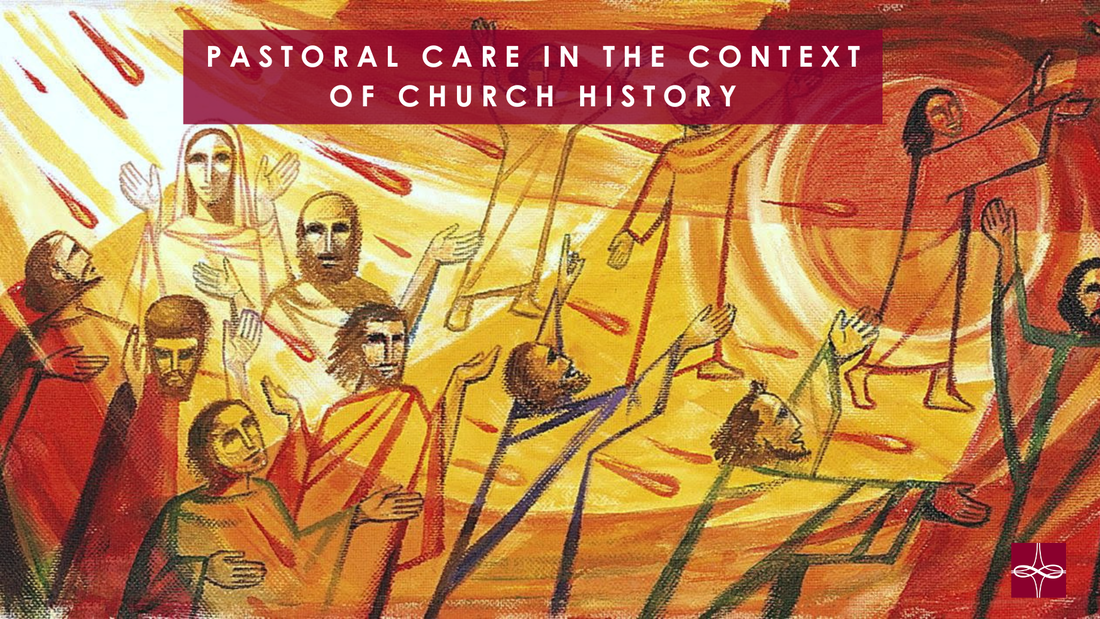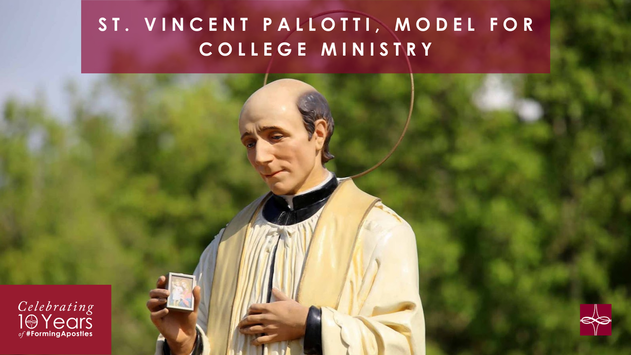|
“This [the Feast of Pentecost] was to show that just as God in creating man had, as Holy Scripture expresses it, breathed into him the breath of life, so too in communicating a new life to his disciples to live only by grace, he breathed into them his divine Spirit to give them some share in his own divine life. The Spirit of God also ought to come and to rest upon you on this sacred day, to make it possible for you to live and to act only by the Spirit’s action in you. Draw him within you by offering him a well-disposed heart.” — St. John Baptist De LaSalle, Meditation 43.1 Every year at Pentecost, the Church celebrates its birthday, and this year — assuming Christ died in 33 A.D. — the Church will be celebrating its 1,991st birthday. That is 1,991 years of preaching, teaching, and pastoral care for the many and diverse people of God. Each day, I work with ninth and tenth graders in a Catholic high school, teaching them about Sacred Scripture and the Catholic Church. While teaching my sophomores about Church History, I continually receive similar questions: “How did the Church care for its people?” “Why did the Church do that when it seems so wrong by today’s standards?” These questions got me thinking about the Church’s choices in caring for the people of God across history and led me to teach Church history by contextualizing Pastoral Decisions within the historical context of the time period. This led my students to a deeper understanding of the ancient, medieval, and modern ages of the Church. I began this blog post with a quote from St. John Baptist de LaSalle on the gifts of the Holy Spirit given to the Apostles at Pentecost because the same Spirit and gifts have guided the Church since that day. In the early Church, the Holy Spirit guided the Apostles to go out from Jerusalem and preach to the people where they were already living their daily lives. Acts of the Apostles discusses Peter and other Apostles preaching in the Temple in Jerusalem, entering the homes of Gentiles, and traveling to cities across the Roman Empire to speak in public spaces. These first missions sought to bring Jesus’s Gospel message to people in their own cultural context, made possible by the Holy Spirit’s gift of being able to speak various languages from Pentecost. The early Church focused its sacramental life on the “breaking of the bread” or Mass, most likely occurring in people’s homes and dining areas in their preferred language, as seen in the Road to Emmaus story. These personal invitations to the Faith yielded great results and the founding of Christian communities across the Roman Empire. These localized communities, however, soon began to consolidate with new pastoral goals and programs in the aftermath of Constantine’s Edict of Milan which legalized Christian worship, and the subsequent shift of Roman religion from paganism to Catholicism. With Catholicism becoming the state religion of the Roman Empire, the Church gradually became a more established institution. Part of this was the adoption of the use of Latin in public liturgy. Since Catholics could now worship in newly founded Basilicas and Churches, a common liturgical language was needed to cater to all members of Roman society. Additionally, when the Western Roman Empire fell in 476 A.D., effectively breaking up the empire into states ruled by different ethnic groups across Europe, the Church stepped in as a stabilizing institution to help govern and rule a fractured continent. The necessities of common liturgical practices and a united Faith leadership led the Church to influence secular medieval and Renaissance rulers. Many in society today — including my students — look at this era of the Church as the height of Catholic control and corruption, and there were several corrupt leaders within the Church. Nevertheless, when shown as a unifying agent of society — with positive and influential leaders like St. Francis of Assisi, St. Dominic Guzman, and St. Thomas Aquinas — the Church’s evangelization and catechesis efforts come to the forefront. Even today, the Church references the documents and principles of medieval and Renaissance theologians to explain how the Church continues to live its authentic witness to the Gospel in the modern age. The Church of the modern age has naturally progressed from its ancient, medieval, and Renaissance roots. The Holy Spirit continues to guide Pope Francis, the Bishops, and lay leadership across the Church to pastorally respond to the modern needs of the Body of Christ. One of the most notable moments of a pastoral shift in the modern era was the Second Vatican Council, allowing greater expression of cultural diversity in the Church, Liturgy, and personal spirituality. Each Pope since Vatican II has continued to further explain and open the documents of the council for consideration and application among the faithful. In 2019, in his Post-Synodal Apostolic Exhortation to Young People in the Church, Pope Francis challenges the reader to “above all, in one way or another, fight for the common good, serve the poor, be protagonists of the revolution of charity and service, capable of resisting the pathologies of consumerism and superficial individualism” (Christus Vivit, No. 174). While addressed to young people to be agents of change in society, this is one of many challenges of Pope Francis that beg the faithful to continue witnessing to the Truth of the Gospel and Jesus’s Mission in their own life. Similar messages have been given throughout the long history of the Church, with the only difference being in language and historical context. The singular unifying agent of the Church’s Pastoral Care throughout history has been the Holy Spirit. Today, we must continue to ask the Holy Spirit for help and inspiration in our daily life to help us go forward with the love of Christ to be positive witnesses of the Church today. **This image is from: https://www.psephizo.com/biblical-studies/the-movements-of-pentecost/**
0 Comments
Pope Francis eloquently writes in his post-synodal exhortation Christus Vivit, “After this brief look at the word of God, we cannot just say that young people are the future of our world. They are its present.” In the last decade, and especially since Christus Vivit was promulgated in 2019, the Church has sought to help the Church’s youth become protagonists in their own right. This is seen in many parish, diocesan, and archdiocesan initiatives to form young Church leaders. Some examples of this include creating new diocesan offices for youth and young adult ministries and the growth of many high school and collegiate campus ministry offices. Nevertheless, young people crave young role models for the Faith. Pope Francis recognized this and listed many examples, including Mary, St. Francis of Assisi, and St. Joan of Arc. In this blog, I wish to discuss three saints in particular--Bl. Carlo Acutis, St. Jose Sanchez del Rio, and St. Therese of Lisieux—and how their witnesses are a model for young people (especially youth leaders) who wish to dive deeper into a relationship with Christ and his Church. Young people everywhere crave to see an aspect of themselves in the people they look up to, and Bl. Carlo Acutis is a soon-to-be saint who allows young people to see commonalities between themselves and the saints. Carlo was a typical Italian teenager who played soccer and video games. Nevertheless, he also made great strides for God in his work, uploading Eucharistic miracles to a website to spread devotion to the Body and Blood of Christ. He was called “an influencer for God” by his mother in an America Magazine article. Bl. Carlo stands as a soon-to-be saint accessible to the Church’s youth because of his young age and his connectedness to 21st-century culture. Bl. Carlo Acutis models for youth leaders how evangelization must occur within the culture and modern media, not from an ivory tower of formal theology and scholarship. The Gospel must be spread in a way that all generations can appreciate, and Bl. Carlo accomplished that with the creation of his website. Another young person who bore witness to the Faith in the context of his own time was St. José Sánchez del Rio. Saint José was a young man growing up in Mexico during the Cristero Wars. The Cristero Wars were a series of conflicts between the Mexican President Plutarco Calles's secularist government and Cristero fighters (formally known as the National League for the Defense of Religious Liberty). The Calles government imposed the 1917 Mexican Constitution, which contained anticlerical policies and sought state atheism. Catholics across the country opposed this and began resisting through liturgical services and military resistance against the Mexican army. Saint José was a young man during the war and wanted to fight to defend his Faith. His mother, however, refused to let him formally join the Cristero Movement. This made St. José contribute to the movement indirectly and attend Mass whenever possible. Nevertheless, when a Cristero General lost his horse in battle, young José offered his, and this led to his imprisonment by the Mexican army. After being tortured to renounce his Faith, José refused and was martyred. St. José Sánchez del Rio’s witness to the Faith is one of the best examples of what a Catholic is called to do by Christ: witness the Faith within your own culture and times while not renouncing our Lord. Despite his young age, St. José believed in Christ’s love and graces, and that gave him the strength to be countercultural and stand with Jesus instead of with the popular culture and the government that stood against Him. Finally, St. Thérèse of Lisieux remains one of the most commanding forces in the Church’s lexicon for youth witnesses. Becoming a Carmelite at age fifteen, Thérèse began to pray incessantly and pioneered her famous “Little Way” for the spiritual life. St. Thérèse’s “Little Way” seeks to help people encounter Christ in their day-to-day activities and pray to Jesus with childlike dependency. St. Thérèse of Lisieux’s powerful devotion to the Eucharist, prayer, and a joyful attitude allow many to realize that one can be close to Christ no matter what they are doing. St. Thérèse stands as a strong role model for young Catholics since her relationship to Christ reached such profound depths at her young age. Young people crave role models in the Church, and older generations can find powerful witnesses and wisdom from young Catholics as well. The Church has been and must remain dedicated to telling and promoting the stories of young saints to inspire every generation to become protagonists in the Church and saints for Christ’s kingdom. Young people can be inspired by these saints since they can “…offer the Church the beauty of youth by renewing her ability to ‘rejoice with new beginnings, to give unreservedly of herself, to be renewed and to set out for ever greater accomplishments’” (Pope Francis, Christus Vivit). **This blog was originally published on August 5, 2021.**
“Therefore, since we have been justified by faith, we have peace with God through our Lord Jesus Christ, through whom we have gained access [by faith] to this grace in which we stand, and we boast in hope of the glory of God. Not only that, but we even boast of our afflictions, knowing that affliction produces endurance, and endurance, proven character, and proven character, hope, and hope does not disappoint, because the love of God has been poured out into our hearts through the holy Spirit that has been given to us.”--Romans 5:1-5
Many of us are taught from a young age that Jesus loves us, stands with us, and listens to our prayers. This reality is easy to accept intellectually but hard to know in one’s heart. As one matures through adolescence and adulthood, troubles seem to build and anxieties can begin to overwhelm. Despite our faith and love in Christ, a deafening silence and perceived sense of loneliness can invade one’s spiritual life. This can occur in a myriad of situations, but I have noticed it is especially common when people experience some sort of transition in their life. By its very nature, dramatic change disrupts routines and occupies the mind with a million more questions than on more “typical” days. Being worried and focused on other aspects of life makes it harder to see and know Jesus in these day-to-day moments. In addition, world events like natural disasters or instances of social or political upheaval can push many members of the faithful into periods of doubt and questioning. The key to getting through these “gray” moments in our spiritual life is through perseverance in the face of doubt, questions, and anxiety. One must dive deep into the moments of grayness in order to come to a better realization of who Jesus is and what true love and faith looks like. Before I continue, however, I want to say that this perseverance is not a perfect problem solver. Instead, taking one step at a time in the spiritual life despite a gray cloud or pall that seems to be hovering over you can be the means to continuing your faith and deepening your relationship with Christ. It is not a quick fix that will make you feel better in a day or two. Rather, perseverance is a method of faith development that looks different for each person. The key to all of this is consistency. Many saints experienced periods of spiritual drought, doubting, and dark nights of the soul (a term coined by St. John of the Cross). Most famously, St. Mother Teresa of Calcutta experienced decades of “hunger for God,” and “the terrible feeling of being ‘unwanted’ by Him.” St. Teresa arguably saw some of the ugliest facets of human life and society, and any person who was ministering to the poorest of the poor would feel some form of burnout and depression. Many Christians today experience these same emotions in their own faith journeys, and instead of giving up and letting go, one must do the counter-intuitive action and cling to Christ more. Although I understand that this sounds cliché, bringing one’s raw questions, emotions, fears, and doubts to Jesus—whether at Mass, Adoration, or even in the car—can help one come to resolutions. Prayer is defined in the Catechism as “the raising of one's mind and heart to God,” and since our hearts are all unique, our prayers to Jesus in “grey” moments look different (CCC 2559). You must find a form of prayer that helps you draw as close to Christ as possible. This prayer can be Adoration with journaling, a Rosary with meditation, talking with friends or a spiritual mentor, or even venting to God aloud when you are home alone. The most crucial part of these moments is that you are praying and talking to God. Lastly, these hard times are normal in the spiritual life. Countless saints have experienced them, and thousands of Catholics are in the midst of them every day. When one enters into these dark nights, one must cling to Christ in the hope that comes from afflictions as St. Paul says in his Letter to the Romans. As St. John of the Cross also says, trust that “in the dark night of the soul, bright flows the river of God.”
"Journeying is precisely the art of looking toward the horizon, thinking where I want to go but also enduring the fatigue of the journey, which is sometimes difficult. … There are dark days, even days when we fail, even days when we fall … but always think of this: Don't be afraid of failures. Don't be afraid of falling . . . This is working every day, this is journeying as humans. But also, it's bad walking alone: It's bad and boring. Walking in community, with friends, with those who love us, that helps us. It helps us to arrive precisely at that goal, that 'there where' we're supposed to arrive.”--Pope Francis
College years are some of the most formative times in a young person’s life. One not only learns the skills they need to succeed in their future career, they also learn professionalism, time management, and make friends that can last a lifetime. One’s faith can also dramatically shift and change in college. As a cradle Catholic, it is hard for me to point to one moment of surrender, acceptance, or conversion to Christ Jesus as my Lord and Savior. Instead, I characterize my faith journey as a slow metanoia, a more methodical reorienting of my heart and mind to Christ through formation and acceptance over time. It was through gradual engagement in The Catholic University of America’s Campus Ministry and communal life that my personal faith began to be transformed and deepened as I grew in relationship with Christ. As I reflect upon my undergraduate faith journey, what stands out to me as transformative experiences that led me closer to Christ have been moments where I have been accompanied by peer and ordained ministers and when I was trusted to accompany others along their faith journeys. In my experience at CUA, I had countless individuals willing to journey with me as I learned and grew in the Faith. Specifically, I had peer ministers who were fellow students that grabbed coffee with me, answered my questions about college and the Church, and even commiserated with me over bad professors or annoying classes. My minister was only a year above me, and being able to ask someone who was so relatable about living one’s Catholic faith in college helped me see how to practically follow Christ’s teachings in my four years at CUA. This accompaniment made me realize that Christ calls the members of the Church to care for each other genuinely and authentically, instead of from a place of authority or condescension. Similarly, I was also introduced to spiritual direction early in my sophomore year, and experiences with my spiritual director allowed me to more fully enter into a relationship with Christ that is comfortable with the highs and lows of the Christian life. My spiritual director wanted to understand my faith journey in all of its facets. He helped me chart a course of discipleship that facilitated an encounter with Jesus Christ both sacramentally and in those around me. This relationship also kept me grounded when I had questions and when hard decisions of life rocked the boat that is my personal faith. The relationships with my Student Minister and spiritual director brought me into the Church’s relational mission that was somewhat absent in my faith life before I arrived at college, and the accompaniment I experienced from these individuals led me to get involved in college ministry. Eventually, I became the proverbial accompanier for first-year students at CUA. Just as being accompanied helped me become more mindful of Christ’s presence in those around me, being the one who accompanies helped me grow closer to Christ as well. I was privileged to be a retreat leader as well as a Student Minister in my time at CUA, and it is from walking with first-year students in these capacities that I have been exposed to new ways of prayer, thinking about God, and living the Christian life as best we can. What has been most impactful from my experience as a Student Minister was walking with my residents as we all made our way back to “in-person” faith throughout 2020 and 2021. Having been isolated from March to April of 2020, my residents and I walked together, helping each other unpack Scripture, become comfortable in Mass again, and encounter Christ differently throughout the pandemic. Even meeting for our weekly Bible study was incredibly transformative after our months of isolation, and our weekly group allowed us to relearn how to worship and reflect as a community again. Journeying with my peers as a lay ecclesial minister allowed me to more deeply encounter Christ in my peers and form a deeper relationship with Him as I was constantly leading or participating in Faith Formation. Throughout my experiences at college, accompaniment and community have been cornerstones of my faith development. I have come to realize that I am accompanied, I accompany others, and through it all, Jesus journeys with me. Jesus’s presence in the Eucharist and in others has helped me remain firmly rooted in His redemptive love that overcomes all human hardship. College years—especially during a pandemic—can be very isolating, but students can grow greatly in their personal faith with faithful accompaniment.
"Since you are ambassadors and ministers of Jesus Christ in the work that you do, you must act as representing Jesus Christ himself. He wants your disciples to see him in you and receive your instructions as if he were giving them to them. They must be convinced that your instructions are the truth of Jesus Christ who speaks with your mouth, that it is only in his name that you teach, and that it is he who has given you authority over them.”—St. John Baptist de la Salle The entirety of the baptized are, as St. Paul says, “ambassadors for Christ,” but St. John Baptist de la Salle—the patron saint of teachers—expands on this idea for educators of the youth. La Salle sees teachers as becoming the image of Christ for students in the classroom. This idea necessitates that teachers teach their disciplines well, but they must also be models of love and virtue for their students. As a Secondary Education and History student observing at a Washington D.C. Catholic middle school, I have recently reflected on my role as a classroom teacher. Teachers, in many ways, become an extension of the domestic church. As children reach kindergarten age, they begin to spend the vast majority of their weeks—close to seven hours a day Monday to Friday—in the care of their teachers. The sheer amount of time students spend with their teachers necessitates that teachers become another guardian for their students. I have seen this first-hand in an eighth-grade class I have been observing. Students look to their teacher for guidance and reassurance, and their teacher provides structure, help, and correction for each student as needed. Particularly, in middle and high school, teachers begin to form students’ adolescent and adult mannerisms, and a teacher’s embodiment of Christ’s charity is essential for students to see how the Christian life is lived. Students crave a person to model, and while Jesus is the perfect example, it is hard for many to conceptualize how Jesus lived as a human being. La Salle explains, “Example makes a much greater impression on the mind and the heart than words, especially for children, for they do not yet have a mind sufficiently able to reflect, and they ordinarily model themselves on the example of their teachers” (la Salle, Meditations for Time of Retreat). A teacher must then step in as a witness to Christ’s mission lived out in the modern world. Teachers cannot be aloof people who look perfect to students. Instead, instructors must show that they are human with the capacity to make mistakes in classroom instruction and in working with their students. Over this semester of observations, I have noticed that students will eventually place their trust in you as they get to know you. As I assisted students with their classwork, asked them questions about their class and school, and talked about life, they slowly began asking me questions and fostering conversations with me. This culminated when I taught a complete lesson on the Roaring 20s and the Harlem Renaissance. My students engaged with me throughout the class period, and they even offered me feedback like a need to slow down a little and explain my slide images more. Students were also appreciative that I did not have all the answers to their questions, but I followed them up by saying, “let me check on that and get back to you.” Teachers must show students that they are an authority on their content and should be a trusted source of knowledge, but they also have limitations and do not know every single fact on a subject. Teachers—like pastoral ministers—must recognize the gravity of their role and hold themselves to a high moral and professional standard, but they must also be down-to-earth and relatable. This relatability in the classroom for middle and high school students allows for a form of collaboration where teachers and students work together to pursue the truth and the Christian life. St. John Baptist de la Salle was constantly trying to teach his order of teaching brothers that they were ministers of the Church and Christ and that the salvation of students lay within their hands as teachers. La Salle asked teachers to give of themselves to inspire their students in their academics and faith lives because he realized that students craved authentic witnesses to the theological and human truths of life. St. la Salle explained himself best when he wrote, “for the love of God ought to impel you, because Jesus Christ died for all, so that those who live might live no longer for themselves but for him who died for them. This is what your zeal must inspire in your disciples, as if God were appealing through you, because you are ambassadors for Jesus Christ” (la Salle, Meditations for Time of Retreat). In many ways, St. la Salle preempted modern evangelization practices with his emphasis on authentic witness as a means to bring people closer to God. To learn more about the saints, visit our Catholic Feast Days Website by clicking here.
“For he knows our frailty, He remembers we are only dust”--St. Thérèse of Lisieux Since Lent of 2022 is already upon us, I would like to pause and reflect on how Lent is a deeply penitential season that can bring us closer to Christ through our love of Him and those around us. I want to consider this by examining St. Thérèse of Lisieux, the Little Flower, and the concept of Merciful Love. St. Thérèse of Lisieux was deeply attuned to Jesus’s love and mercy for all mankind, especially when it came to little souls who had a repentant heart. St. Thérèse expresses her devotion to the Divine Mercy across her many writings, and her insights shaped her “Little Way” into Jesus’s merciful heart as it is poured out to sinners. However, many reject Christ’s mercy, not believing it to be the free gift it is. In my opinion, this is one of the hardest realities to accept in the spiritual life because of its ubiquitous nature. As humans, we are constantly anxious that we are offending God, inadvertently hurting those around us, and making mistakes in our day-to-day lives at work or in school. But no matter the situation, anxiety, or fault, Christ’s mercy enters that space and works to heal us, even if we do not acknowledge it or if we reject it outright. Jesus comes to us and can live in us no matter what. St. Thérèse points to Jesus’s Infinite love and mercy as a model for our own love. In Story of a Soul, she writes, “How good is the Lord, his mercy endures forever! It seems to me that if all creatures had received the same graces I received, God would be feared by none but would be loved to the point of folly; and through love, not through fear, no one would ever consent to causing Him any pain.” Lent is a time of Prayer, Fasting, and Almsgiving that is focused on love of God and love of neighbor. The three core pillars of Lent are not ends in themselves; they are a means to grow closer in relationship to Jesus, the Church, and those who live in our communities. Christ offers us his love and mercy so that we can extend them to those around us, and once we accept His gifts, we are changed forever. Nevertheless, one must trust God in His love, and we must see ourselves as reflections of His love. Much of St. Thérèse’s writings and spirituality revolve around being a small child before God. Our littleness allows the Lord to love and minister to us as He intended since we cannot attain the heights of the Christian life on our own. Instead, Jesus and the Holy Spirit draw near to illuminate the darkness in our lives with their love. Yet, despite the presence of Christ in our lives, we turn away from Him, and this then allows us to run back to Him as the Prodigal Son did. This turning back to God fosters deeper trust in God within our hearts. St. Thérèse enunciates that we have to receive and accept our brokenness and the reality that we will never be perfect. Once this occurs, we gain a relationship with Jesus. Through His love for us, we see ourselves as a vessel for His love. We value our own selves as well as helping those around us. We Christians move outward to love the world as Jesus called us to do through God the Infinite Love and Infinite Mercy. To learn more about the saints, visit our Catholic Feast Days Website by clicking here.
St. Vincent Pallotti, the Missionary of Rome, was a Roman Diocesan priest of the 19th century whose life, works, ministry, and witness offer the best models for modern lay ecclesial ministers, especially lay college ministers. Pallotti was a theologian ahead of his time, founding the Union of Catholic Apostolate and Society of the Catholic Apostolate to propagate and revive the faith among practicing Catholics while fostering a more profound devotion of love by rekindling charity. The implementation of this ideal is still needed in today’s Church, and here is where lay ecclesial ministers come in. When ministers work for Pallotti’s goals of reviving faith and rekindling charity within a Cenacle or community-based mindset, countless people in the larger Church community can be touched and impacted. I have worked in college ministry for two years now as a peer minister, and Pallotti’s ideals have led to my ministerial community’s most fruitful work since we sought to help the needs of the greater college campus community through intentional accompaniment.
St. Vincent Pallotti—much like saints Francis, Dominic, Thérèse—sought to help mend the gaps in the Church by giving all Catholics more ways of achieving holiness. Pallotti founded the Union to help Romans become better Catholics, and modern ecclesial ministers continue this. On college campuses today, many students who identify as Catholic can be lost in the cracks of campus life if they are not actively seeking faith formation and development. Pallotti and his contemporaries went out, looking to meet people where they were and teach them along the way. College ministers must do the same. Instead of forcing program after program (whether Bible studies of social events) onto their students, ministers should instead meet people one on one, learn about their unique qualities, and intentionally invite them to go deeper into their faith. Large-scale social events or small intimate groups like a Bible study allow for an initial contact with students, but these events are not ends in themselves. Instead, they should lead to more connection and discussion. These deeper conversations are what allow faith to be revived. Ministers and those they accompany collaborate to learn more and better live the Christian life of loving charity. However, ministers must look to each other for support and collaboration. Fruitful ministry cannot come from one person alone. Like Pallotti, ministers must work in a Cenaclespirituality, utilizing others’ gifts, talents, and observations to improve everyone’s individual and the overall community’s ministry. To teach a fellow priest how one’s smallest actions deeply affect others, Pallotti used the money he got from selling excess paper to help minister to a man on his deathbed. Pallotti then turned to Father Paul de Geslin and said, “Now you see the importance of even little scraps of paper.” College ministers must work with the same mindset. The way one lives their own life, interacts with community members, and participates in the greater campus community serves as a witness of Christ to the whole campus. Simple day-to-day interactions allow people to encounter Christ through their actions. Small acts like checking in on a stressed resident can enable them to feel cared for, reach out, and take the initiative to revive their own faith life. Too often lay ecclesial ministry, especially on the college level, boils down to how many people came to a specific event, leading to a discussion of whether resources were utilized well. While good stewardship is necessary in ministry, numbers cannot fully reflect how well the ministry was done. Event statistics show how well a ministry is reaching the community, but it does not account for the small interactions or the “scraps of paper” that make ministry fruitful one-on-one. Ministry must be viewed both on a large scale and on a small scale. The Sermon on the Mount and Jesus meeting the woman at the well are equally important, and both show good ministry. St. Vincent Pallotti’s dedication to reviving faith and rekindling charity makes him a model for all the Church’s ministers, especially college students. Pallotti worked to show people ways of living a charitable and faith-filled life by walking with them and living among them. This is why college peer-ministry is integral to young adult ministry. College students must see role models who live virtuous faith-filled lives on campus that engage with the greater community and campus culture. Ministers are not meant to live and work in a monastery of a perfect Christian life. Instead, they are meant to engage with others and live their lives with the community. Like Pallotti and his peers, ministers must also draw strength from each other and learn more about those they are ministering with by working collaboratively. This Cenacle spirituality allows for greater engagement in ministry by creating programs and fostering relationships of accompaniment aimed at developing faith for all involved. Finally, the Holy Spirit moves within pastoral communities at all levels of the Church to deepen the Cenacle Spirituality to strengthen its ministers to go out and serve others instead of being inwardly focused. The Holy Spirit inspires lay ecclesial ministers to embrace their individual charisms, recognize others’ gifts, and utilize shared talents to serve others and bring them the Good News. Through Pallotti’s example of ministry, one can “seek God in all things” and “find God in all things.” For more resources on St. Vincent Pallotti on our Feast Day site, click here. To view our Pallotti Portal, click here. For more resources on Lay Ecclesial Ministry, click here.
Social media has been gaining momentum in the Catholic world since the mid-2010s; however, since the COVID-19 pandemic began, digital evangelization and virtual faith-sharing have become even more important and prevalent. Because in-person liturgies, retreats, and daily interactions were not possible, Church organizations across the U.S. began to increase their digital footprint. Although the Catholic Apostolate Center has used technology and social media as tools for evangelization since its inception in 2011, the COVID-19 pandemic also led the Center to a greater focus on digital evangelization and online formation tools. As an intern with the Catholic Apostolate Center, my time has been punctuated by helping people encounter the Church and faith formation more positively. Specifically, expanding the Center’s courses on Catholic Faith Technologies’ e-learning platform and building an app for the Immaculate Conception Province of the Pallottine Fathers and Brothers has allowed me to create new ways for people to encounter Jesus Christ and learn more about Him. Pope Francis has followed the footsteps of his predecessors by encouraging the Church to continue evangelization over the internet. Our Holy Father has stressed the importance of using the technological means available to us today in order to proclaim the Gospel “to all the nations.” This evangelization can come in many ways and forms, and the Catholic Apostolate Center has embraced this understanding since its foundation. This summer, I have been working on adapting the Center’s “Apostles on Mission” in-person course to be an asynchronous course online with Catholic Faith Technologies’ e-learning platform. As a secondary education major, I was able to hone my skills as an educator by looking at the lesson outlines and plans and advising a break, an activity, or a different method of conveying the content to increase engagement. This project has also helped me look at what intellectual faith formation means and why it is so pertinent to the spiritual life. Formation in the Church calls us to learn more about Jesus, the Church, our Faith, and our own strengths and weaknesses. However, with the advent of the internet, we must cast the net over the right side of the boat, as Jesus calls us, to reach more people and continue to spread the Gospel message. Expanding digital resources for faith formation allows all the faithful to grow closer to our Lord. Digital evangelization can also allow for a more profound personal encounter with Jesus Christ. As seen throughout the pandemic, prayer resources can help people feel connected to the greater Church community. People want to experience various types of prayer to delve deeper into the spiritual life. The Catholic Apostolate Center has been working tirelessly this summer to create a prayer app for the Immaculate Conception Province of the Pallottine Fathers and Brothers. This app—entitled “Revive & Rekindle”—will assist the Pallottine community and the general faithful in growing closer to Christ through the spirituality of St. Vincent Pallotti. This project has allowed me to make two important observations about the Catholic faith. First, we must promote various forms of prayer and devotion to help the faithful find the styles of prayer that best suit them. Second, prayer and devotion must be disseminated and promoted in different media to spread the Gospel message to as many people as possible. The “Revive & Rekindle” app will allow people to grow closer to Jesus through reflections and prayers inspired by St. Vincent Pallotti, who urges us all to become Apostles for the Lord. As a strong proponent of the New Evangelization, Pope Francis encourages us to enter the digital landscape to encounter people and bring them closer to Christ. The Church can only do this through intentional formation and by promoting an encounter with Christ online. As an intern at the Catholic Apostolate Center, I have grown professionally, personally, and, most importantly, spiritually. Working with the Center, I have concretely realized what Pope Francis means when he urges young people not to “wait until tomorrow to contribute your energy, your audacity and your creativity to changing our world. Your youth is not an “in-between time” (Christus Vivit). A vast majority of people in the United States have social media, and since many Catholics are among this number, we have to preach the Gospel on all channels and encounter others and Jesus Himself through means of digital formation and evangelization. We must reach out to all corners of our world and society to be Apostles on mission for Jesus.
|
Details
Archives
July 2024
Categories
All
|
About |
Media |
© COPYRIGHT 2024 | ALL RIGHTS RESERVED













 RSS Feed
RSS Feed